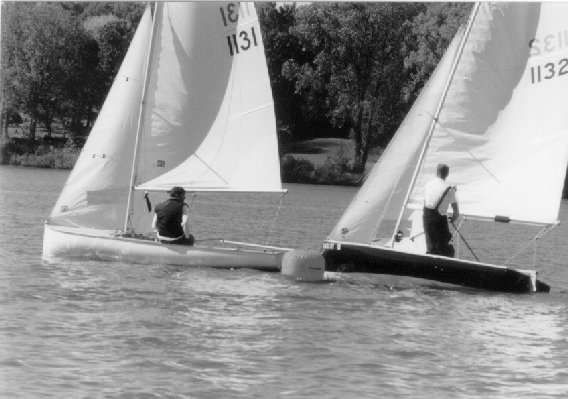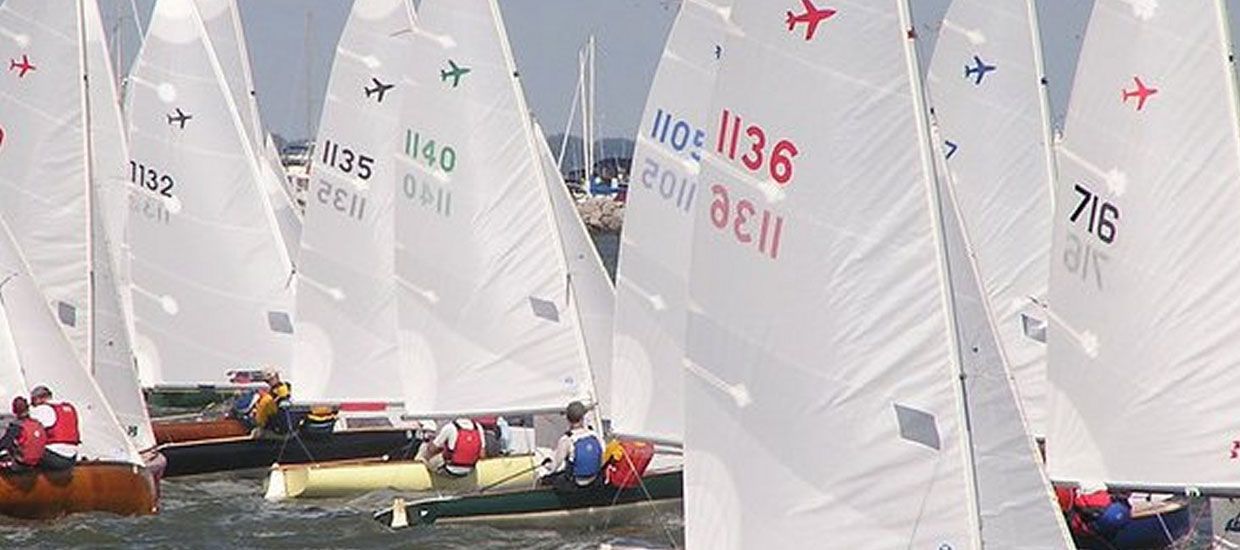Winning in Jet-14s
Circa 1996
The Jet-14 Class Association asked former Jet builder Bill Buckles, Doyle sailmaker Greg Koski, and past National Champions Marion Zaugg and David and Anne Whitmore Hansen to discuss the most important aspects of boat speed, sails, tuning, strategy and crewing. This is not an exact, word-by-word transcript, so any mistakes are the editor's. For a video of this SailEXPO '96 seminar, call Charlie Engler, (908) 464-5564.
Bill Buckles, Jet 1131
Stiff is fast. To have a competitive boat, you want your hull as stiff and as smooth as possible, so your boat will cut through the water as cleanly, as efficiently, and as fast as possible.
Every boat flexs some. But if your hull's too flexible, you need to make it stiffer without adding extra weight. Brace it the way water goes, fore to aft, not thwart to thwart. You want to disturb water molecules as little as possible, and if you brace it crossways you create flat spots between frames, areas that confuse water molecules.
You want your boat to be fair. Turn over your boat, wet the hull, and check the reflections to see how smooth the bottom is. Even 1131's brand new hull had ripples from the molds, but because I'd had extra gelcoat, I could be pretty aggressive smoothing it - more aggressive than you'll probably be able to be with older glass boats.
It's very important that leading and trailing edges of your blades are as sharp as class rules allow. Your hull creates about 20 percent of disturbance, board and rudder about 80 percent. The half-round leading edge, the maximum allowed by Jet class rules, isn't a particularly efficient board edge. A bullet-shaped leading edge, until it it nicked, is more efficient; a rounded edge is efficient over a larger range. You want the board to go through the water as cleanly as possible, which is why, even if your boat is heavy, the heavier 1/4-inch steel board is more efficient than a 3/8-inch aluminum board.
As you become a more experienced, I recommend you get a more limber mast. You want a mast as limber as you can handle in order to get the most efficient sail shape possible.
Greg Koski, New Jibetech Jet
Boat preparation's important. Your boat's bottom, board and rudder should be set up and your boat tuned the way you want it. Then, there's your engine and driving force, your sails. If you have bad skins, you won't go very fast.
Sailmakers are using yarn-tempered fabric, a firm-finished fabric that doesn't shift around a lot or loosen or stretch very much. You should get two good years of top-of-the-line performance from most Jet sails. Take care of your sails. Roll, don't fold, them without the battens. You don't need new sails every year; in fact there are times when you want to use older, less stiff, fuller sails, say down on that wind tunnel, Lake Mohican, during the 1995 Nationals.
 Sails have built-in options and controls: foot shelves, cunninghams, etc. Use them. Use your jib cunningham to ease cloth tension, flatten the front edge to point higher and go faster. Round it off on reaches. In a jib you want a clean exit. Jet sails are powered down low. Use your main cunningham to pull the draft forward on older sails. I sail test a lot with Marion - we put sails up and down and change boats - that helps me monitor the sails. Check your sail fabric. If you can blow through your spinnaker fabric, it's time for a new one.
Sails have built-in options and controls: foot shelves, cunninghams, etc. Use them. Use your jib cunningham to ease cloth tension, flatten the front edge to point higher and go faster. Round it off on reaches. In a jib you want a clean exit. Jet sails are powered down low. Use your main cunningham to pull the draft forward on older sails. I sail test a lot with Marion - we put sails up and down and change boats - that helps me monitor the sails. Check your sail fabric. If you can blow through your spinnaker fabric, it's time for a new one.
Marion Zaugg, Jets 180 and 1132
Tuning's part of the boat-speed equation. Tuning and triming are two faces of the same coin: Tuning - changing your rig tension, mast rake, smoothing your bottom, etc.- is something you do before you race; trimming is what you can do during the race.
Where do you start? Greg's catalogued his work and Bill's kept notes on how 1131's setup and how it performs. The class should have a tuning guide available soon. We've had a lot of different builders, so every boat is ever so slightly different. Any class tuning guide is just a starting point. You will need to tune your boat with your weight and crewing. It's a constant process. For starters: Look at the fast boats, observe them on and off the water, talk to them, see how they have their boats set up.
Determine how your boat is working. How well are you going. Test it. Establish benchmarks. Sail upwind with another boat, see how you point. Racing's not the best time for testing since there are so many distractions, but try sailing a regatta as a tuning regatta if you don't have a tuning partner. Experiment and change trim adjustments as methodically as you can, one thing at a time. Keep notes: What are you doing in what conditions with whom? Keep notes: What did you change and what was the result?
If your rig's set up right, you'll have good boat speed.
Be able to trim without thinking. If you don't have to worry about what's going on in the boat, you can concentrate on the race as a whole. It's also important you have a competitive hull, so if you're buying a used boat, check its weight, etc.
David Hansen, Jet 1066
Marion, Greg and Bill talked about tuning, sails, and hull preparation. I want to talk about preparation, practice and boat handling, and getting around the course.
Set your boat up so it works for you and it's comfortable for you and your crew. For instance, you want to be able to adjust the vang while hiked out. Have your boat ready before you hit the water.
Racing doesn't take the place of practice, and probably none of us practices enough. The more you practice, the more you're on the water, the more you develop good boat handling skills, the better you'll do. Go out with the person you sail with and concentrate on specifics. Repetition's important. Put the chute up again and again, work and talk to each other.
Sail your boat flat so you go through water as easily and cleanly as possible. Copy the top finishers: Look at their weight distribution, how flat they sail, and what their sails look like.
Sail aggressively. A Jet likes to be worked, and it responds well to rolling hard through a tack, bringing your weight down hard, and pulling the main sheet. Come out of a tack as fast as you can, by letting the boat roll and steer itself through. You don't want to be pushing and pulling the tiller. Pull off the tiller on a calm day and steer through weight balance and sail trim.
Learn the rules. They are part of the sport and work to your advantage. If you know them you, you know what you can and cannot do and you'll stay out of the the protest room. But, if you've a chance, sit in on an open protest hearing. You'll learn alot.
On race day, get out to the course early so you can check wind conditions, get comfortable and plan strategy. Sail upwind in racing mode and check your sail trim. See if there's a favored side of the course or a favored end of the line.
It's very important to get off the line well. Be on the line with room around you driving at top boat speed when the gun goes off. If you don't get a good start, clear your air at the first opportunity. Try to stay in phase with the leaders and try not to get forced out to the sides because you'll lose opportunities to play shifts or clear your air.
Mostly Anne and I stay in the middle and work the shifts.
Anne Whitmore Hansen, Jet 1066
Dave and I have been sailing Jets for about 20 years. A Jet goes with you through different stages. I sailed as a junior, then with my brother, now Dave and I are a team. A Jet is a good boat to learn to sail in, to crew in, or to make the transition from crew to skipper.
Organization, communication and attitude are very important. Organization starts on shore. It helps if one person makes sure everything's in the boat: equipment, tool bag, racing instructions, sunscreen, water, lifejackets, racing instructions, all the gear. Out on the water organization's making sure lines run free, the spinnaker's not twisted, etc. Test the spinnaker. Put it up before the race and stuff it slowly so at least it will go up well once.
Dave and I talk pretty constantly. I feed him information about where I see wind on the water, where I see a flat spot if it's choppy and time to tack so we'll come out of the tack faster, what other boats are doing, about port-starboard situations, etc., so Dave can concentrate on keeping the boat in the groove. We talk about what we're doing. We talk through takedowns at the leeward mark before we do it although we usually do it the same way every time.
Communication's very important. Our speed goes down as soon as we stop talking - usually that's when there's a problem. If there is problem, we try to keep it positive by discussing what we're going to do to adjust. The negative stuff, the 'I told you so' stuff, isn't a lot of fun. It's important to keep it fun because we're out there with our friends and out to have a good time.
Comments
Randy Bruns, Jet 1126: I've been sailing about 20 years, too, and wonder about the differences. One is learning when you're young, so you can sail without thinking. When I'm concentrating on sailing fast, I not looking at everything I should look at to win.
Bill Buckles: You can't beat tiller time and the confidence tiller time gives. I sail in different classes with different competitors with different styles, so I don't get so surprised and can concentrate on sailing. Those with less experience, even though they go fast, lose on the corners because they don't have as good boat handling skills. Bad boat handling wipes out the best tuning, the smoothest hull. If you don't handle the boat well, you look slow even though you're not. That's why you have to practice, that's why practice is not a race. Practice is practice.
Charlie Engler, Jet 1029: Do you have time to look around, Marion?
Marion Zaugg: If I start thinking about some mistake I made, I stop looking at the big picture. I try not to get distracted and try to keep focused on boat speed.
Ralph Hansen, Jet 555: I've found if you have confidence in your boat, you can concentrate on racing.
Dave Hansen (DH): I don't have to think about the boat when I get into a Jet, because I'm so comfortable in it - I know exactly where I can cross on port tack. I have to concentrate a lot more on other boats.
Dave Irey: I think the real secret is constant concentration, no matter how long you've sailed. Who looks around when you're sailing downwind?
DH: I do. How much do you defend your position in luffing battles?
Anne Hansen: We try to keep track of what all the boats are doing and not get caught up in a luffing battle. We love them if we're coming from behind because we can make out like bandits.
DH: Best response is steer up quickly and throw them off guard. Slow climbs are deadly.


